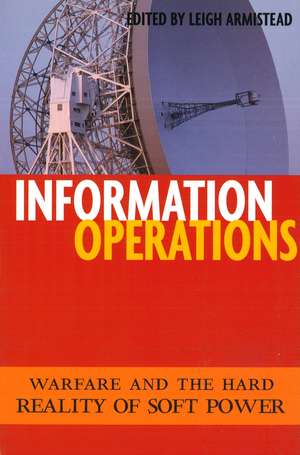Information Operations: Warfare and the Hard Reality of Soft Power
Editat de E. Leigh Armisteaden Limba Engleză Paperback – 30 apr 2004
The modern means of communication have turned the world into an information fishbowl and, in terms of foreign policy and national security in post-Cold War power politics, helped transform international power politics. Information operations (IO), in which time zones are as important as national boundaries, is the use of modern technology to deliver critical information and influential content in an effort to shape perceptions, manage opinions, and control behavior. Contemporary IO differs from traditional psychological operations practiced by nation-states, because the availability of low-cost high technology permits nongovernmental organizations and rogue elements, such as terrorist groups, to deliver influential content of their own as well as facilitates damaging cyber-attacks (“hactivism”) on computer networks and infrastructure. As current vice president Dick Cheney once said, such technology has turned third-class powers into first-class threats.
Conceived as a textbook by instructors at the Joint Command, Control, and Information Warfare School of the U.S. Joint Forces Staff College and involving IO experts from several countries, this book fills an important gap in the literature by analyzing under one cover the military, technological, and psychological aspects of information operations. The general reader will appreciate the examples taken from recent history that reflect the impact of IO on U.S. foreign policy, military operations, and government organization.
Conceived as a textbook by instructors at the Joint Command, Control, and Information Warfare School of the U.S. Joint Forces Staff College and involving IO experts from several countries, this book fills an important gap in the literature by analyzing under one cover the military, technological, and psychological aspects of information operations. The general reader will appreciate the examples taken from recent history that reflect the impact of IO on U.S. foreign policy, military operations, and government organization.
Preț: 147.84 lei
Nou
Puncte Express: 222
Preț estimativ în valută:
28.29€ • 30.25$ • 23.59£
28.29€ • 30.25$ • 23.59£
Carte disponibilă
Livrare economică 27 martie-10 aprilie
Preluare comenzi: 021 569.72.76
Specificații
ISBN-13: 9781574886993
ISBN-10: 1574886991
Pagini: 240
Dimensiuni: 152 x 229 x 18 mm
Greutate: 0.44 kg
Ediția:New.
Editura: Potomac Books Inc
Colecția Potomac Books
Locul publicării:United States
ISBN-10: 1574886991
Pagini: 240
Dimensiuni: 152 x 229 x 18 mm
Greutate: 0.44 kg
Ediția:New.
Editura: Potomac Books Inc
Colecția Potomac Books
Locul publicării:United States
Cuprins
List of IllustrationsForeword – Dr. Dan Kuehl, Information Resources Management College, NDUAcknowledgementsIntroductionThe First Battle of a New Kind of War Electronic Disturbance TheatreThe Basis for the BookChapter 1 - Foundations - The Language of Information OperationsPower - What is Power?Power in the Cold War Era - What has changed?Military Power and Asymmetric ThreatsInformation Operations TheoryIO Theory and DoctrineDifferences between IW and IOThe Evolution of IO DoctrineInformation Operations OrganizationsTop-Level LeadershipIO and the Interagency ProcessDOD - OSD and IODOD - Combat Support AgenciesThe NSA's IO ArchitectureThe DISA's IO ArchitectureDOD - The Joint Staff and IOThe CCsAdditional DoDIO ElementsCabinet IO InterestsDepartment of State IO ConcernsTraditional DOS StructureDOC IO ArchitectureDOJ IO ArchitectureTransnational IO GroupsSummaryChapter 2 - Intelligence Support – Foundations for Conducting IOThe Application of IOThe Intelligence CycleThe Intelligence CommunityIO and the IPBThe Releaseability Issues of IOConclusionChapter 3 –Information Protection- The Challenge to Modern BureaucraciesDefensive Information OperationsInformation Assurance and Computer Network DefenseA View of Defensive Information OperationsCounter-Terrorism Information Operations What is Terrorism?Combating TerrorismFundamentals of CTIOPDD-62 (Counter-Terrorism)Domestic Counter-Terrorism OperationsPartnerships for Counter-Terrorism: “Track Two Diplomacy”PDD-63 (Critical Infrastructure Protection)SummaryChapter 4 –Information Projection - Shaping the Global VillageOffensive Information OperationsComputer Network AttackSpace and its Relationship with IOThe Relationship Between EW and IOPerception ManagementHistory of IPIOutside Influences on IPIWhat is IPI?What was the Clinton Administration attempting to do with IPI?Why has IPI been "less than successful?'Current Bush Administration EffortsIO in Operation Enduring FreedomThe Structure of the OEF CoalitionOEF ObjectiveConclusionChapter 5 – Related & Supporting Activities/Organize, Train, and EquipIO PlanningMilitary IW Service CentersIO Planning ToolsStrategy-to-Task PlanningTying together Strategy-to-Task Planning and IO Planning ToolsIO and JOPESOPLAN, TPFDD and the IO CellIO Cell ResponsibilitiesIO as an Integrating StrategyLegal Issues Connected with IOAn Overview of the Legal LandscapePeacetime Treaties Impacting IOLaw of Armed ConflictDomestic LawThe Solution for the Operator: IO ROE PlanningSummary of IO Planning and Legal IO ConcernsChapter 6 – Implementing IO/Recent CampaignsThe Growing Role of Information in RussiaInformation SuperiorityInformation SpaceRussian IW Terminology and TheoryInformational-PsychologicalMilitary-TechnicalSystemological AspectsIO in KosovoThe Use/Misuse of IO in Operation Noble AnvilAn IO After-Action ReportHow an IO Campaign may have succeededInformation Warfare and the People's Republic of ChinaChinese IO as a Warfighting NetworkWhat is the future of IO in China?Introduction to IO in Australian Defence ForcesThe Evolution of IO and Related Concepts in AustraliaThe Australian Doctrinal Approach to IOThe Australian Experience of IO – Two Case StudiesBougainville - BackgroundIO Contribution to Operation BELISIEast Timor - BackgroundIO Contribution to Operation STABILISELesson Learned and Directions ForwardSummaryConclusion: What is the Future of Information Operations?APPENDIX A – National IO OrganizationAPPENDIX B – IO AcronymsAPPENDIX C – IO and JOPESContributor's BiographiesEndnotes













